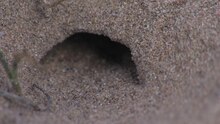Cone bees
| Cone bees | ||||||||||||
|---|---|---|---|---|---|---|---|---|---|---|---|---|
|
Cone bee covers its own need for nectar |
||||||||||||
| Systematics | ||||||||||||
|
||||||||||||
| Scientific name | ||||||||||||
| Coelioxys | ||||||||||||
| Latreille , 1809 |
The cone bees ( Coelioxys ) are solitary bees and belong to the Megachilidae family within the bees . They are named after the peculiar shape of their abdomen. About 45 species are known worldwide, 28 of them occur in Europe, 16 of which are also native to Central Europe. This makes them one of the largest Central European genera of cuckoo bees .
features
The different species of the genus are difficult to distinguish from one another. Their body is moderately hairy and has no modifications for pollen transport. The head and thorax are broad, the compound eyes large. The front of the abdomen is as wide as the thorax, but in the females it tapers evenly backwards so that the abdomen has the shape of a cone. The tergites of the abdomen are colored black, at the end there is a well-separated, fine, light, rarely yellow-brownish bandage or a scaling or similarly colored hair spots. The drones can be recognized by six to nine thorns at the end of the abdomen.
Way of life
Cone bees do not collect pollen and nectar for their offspring, but develop as brood parasites in other bee species. Their host range includes numerous species, such as mason bees ( Osmia ), fur bees ( Anthophora ), hybrid bees ( Trachusa ) and leafcutter bees ( Megachile ). Since each species has its own specific host species, and these have become rare in some cases, some cone bees are also endangered or threatened with extinction. The adult cone bees are polylectic and feed on a wide range of different nectar plants. Cone bees fly in one generation from May to September each year, depending on the flight time of the respective host species. A second generation per year is possible for some species.
Reproduction and oviposition
Little research has been done into the mating behavior of cone bees. The behavior of Coelioxys echinata is known and is probably also characteristic of the other species in the genus. One or, more rarely, several female cone bees pierce the sealed brood cell and the pollen supply of their host with the end of their abdomen. The egg is placed so that it touches the pollen. The larva hatches after just three days and initially only feeds on the pollen supply, after a further six to seven days it has large and powerful mandibles and eats the host's egg or the hatched larva. If several cone bees have laid their eggs in the same brood cell, the larvae fight each other until only one remains. If the host and / or competitors have been killed, the remaining pollen supply is eaten up. Pupation takes place a total of 11 to 16 days after hatching in a cocoon . The overwintering takes place as a prepupa.
species
- Scale-haired cone bee ( Coelioxys afra ) Lepeletier, 1841
- Coelioxys alata Forester, 1853
- Coelioxys aurolimbata forester, 1853
- Coelioxys brevis Eversmann, 1852
- Coelioxys caudata Spinola, 1838
- Coelioxys conoidea Illiger, 1806
- Coelioxys echinata Forester, 1853
- Coelioxys elongata Lepeletier, 1841
- Coelioxys emarginata Förster, 1853
- Coelioxys haemorrhoa Forester, 1853
- Coelioxys inermis Kirby, 1802
- Coelioxys lanceolata Nylander, 1852
- Coelioxys mandibularis Nylander, 1848
- Coelioxys obtusa Pérez, 1884
- Coelioxys polycentris Forester, 1853
- Four-toothed cone bee ( Coelioxys quadridentata ) (Linnaeus, 1758)
- Reddish cone bee ( Coelioxys rufescens ) Lepeletier, 1825
swell
- ↑ Coelioxys. Fauna Europaea, accessed December 28, 2007 .
literature
- Heiko Bellmann : bees, wasps, ants. Hymenoptera of Central Europe . Franckh-Kosmos Verlags-GmbH & Co KG, Stuttgart 1995, ISBN 3-440-09690-4 .
Web links
- www.wildbienen.de
- Checklist of the Apidae of Germany ( Memento from September 23, 2008 in the Internet Archive )
